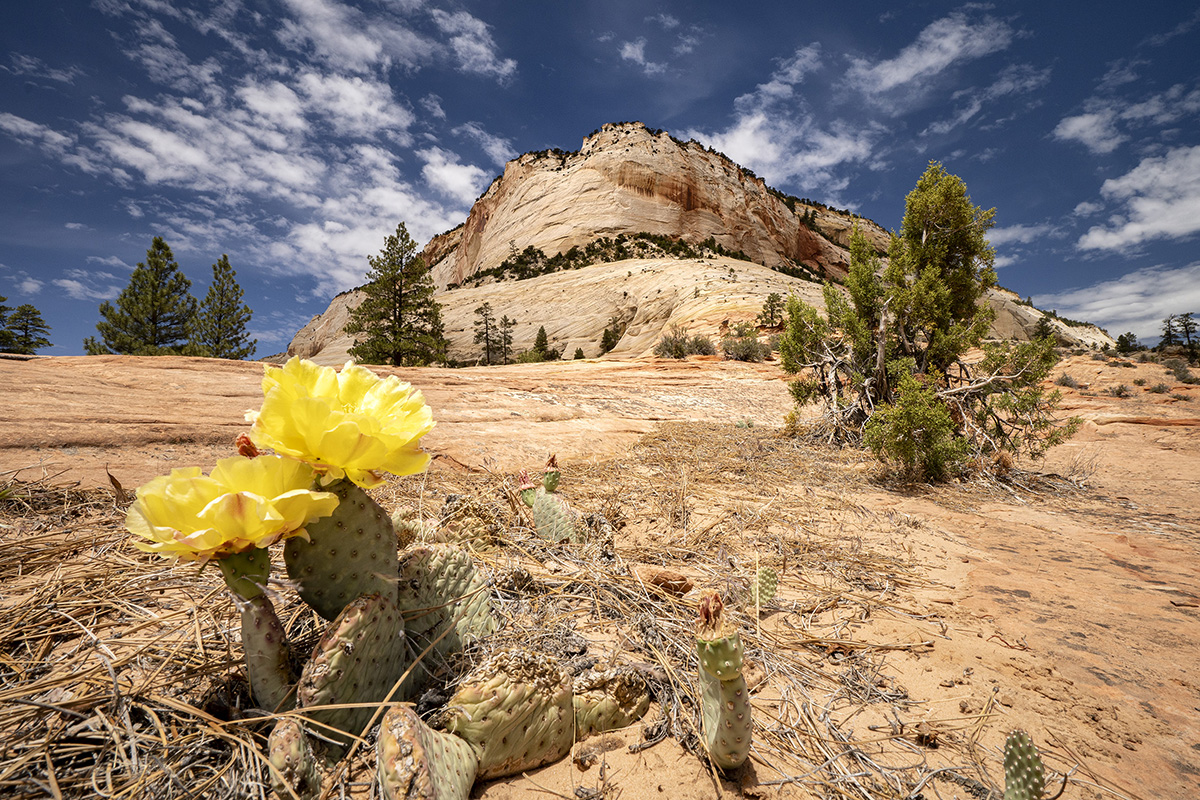Southwest Sojourn
Ken Hubbard explores otherworldly Utah and Arizona landscapes with his Tamron 11-20mm F/2.8 wide-angle zoom.
More Photo Tips | Video Gallery | Photo Gallery | Enewsletter sign-up
By Jenn Gidman
Images by Ken Hubbard
In May, Ken Hubbard embarked on his first extended adventure since the pandemic started, heading 2,500 miles from Long Island to the American Southwest. Along with Tamron colleague André Costantini, Ken visited Utah’s Zion National Park, the remote White Pocket sandstone formations at Vermillion Cliffs National Monument in Arizona, and Great Chamber, a giant sand dune tucked away under a cove in Utah’s Grand Staircase-Escalante region. “Traveling these days is definitely different than it used to be,” Ken says. “But it’s worth it for the reward that awaits—getting to experience and take pictures of these amazing locations again.”
For his journey west, Ken packed his new Tamron 11-20mm F/2.8 Di III-A RXD, the world’s first F/2.8 wide-angle zoom for Sony E-mount. “In the Southwest, it's all about expansive, grand landscapes, but in some locations, like White Pocket or Grand Chamber, you can sometimes find yourselves in canyons and crevices that are a bit more contained,” Ken says. “The 11-20 lens is super-handy in those situations, because you can set your subject close to you, and even the subjects that are far away aren’t so far that they’re tiny in your scene. That helps you to create more dynamic, compelling photos.”
For a sunrise photo in Zion, Ken was able to capture a photo he wouldn’t have been able to with a telephoto lens. “As the sun was coming up over the horizon and lighting both of the mesas you see here, I was able to use the 11-20 to capture not only the toadstools and tree in the foreground, but also both of the mesas to the left and right,” he says. “The landscape is so wide that if I hadn’t had the 11-20, I would’ve been limited to taking photos of my foreground elements and maybe one of the mesas, but definitely not all of those elements together.”
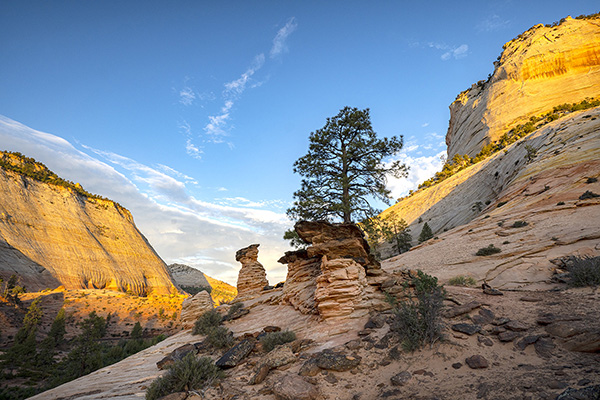
11-20mm (11mm), F/16, 1/15th sec., ISO 200
Click image to view larger
For another Zion photo, Ken wanted to concentrate on the textures and lines in the foreground of the image as the sun hit the clouds in the background. “I always look for leading lines that will take the viewer through the frame, from the foreground to a subject or the background,” he says. “By getting down low, about 8 to 10 inches off the ground, I was able to photograph the lines here leading to the mesa across the valley.”
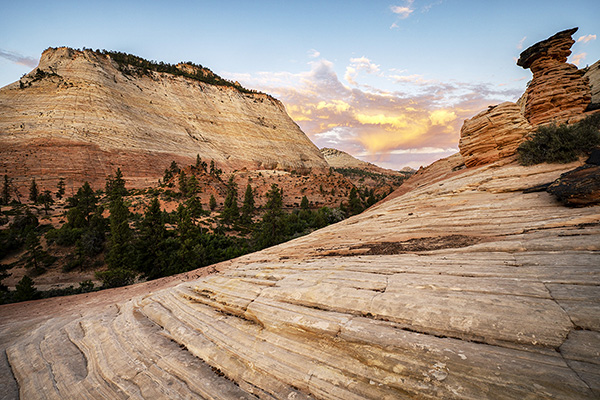
11-20mm (11mm), F/14, 1/4th sec., ISO 200
Click image to view larger
To get to Great Chamber, it’s necessary to rent a four-wheel-drive vehicle or commission a guide—and Ken recommends wearing sandals like Tevas, not sneakers or boots. “The sand is so fine as you climb up the dunes that you just sink into it,” he says.
Over the years, an arch emerged out of the sandstone rock, and as the sandstone fell off and crashed to the ground, it created the sand dune underneath, making for a perfect photo opp. “It’s a massive space,” Ken says. “Even with an ultra-wide angle like the 11-20, it’s hard to capture the real feel of it. That’s why I had André trudge up there so I could add some scale to the photo and show how immense that spot is. Otherwise, you wouldn’t know if the arch was 10 feet high or 100 feet high.”
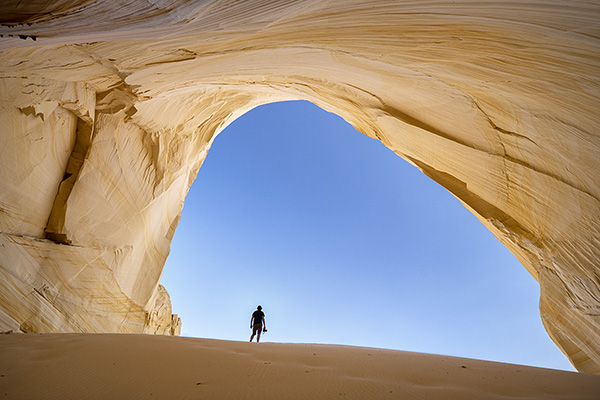
11-20mm (11mm), F/11, 1/20th sec., ISO 100
Click image to view larger
With its close-focusing macro feature, the 11-20mm will focus to 0.15m at 11mm, for 1:4 magnification. “I’ve been to Zion many times and haven’t seen many blooming desert flowers, but this time there were a bunch of them,” says Ken. “Having that minimum focus at the widest angle makes the foreground subject even grander and more exaggerated. A 6-inch flower ends up becoming the focal point, which creates a more dynamic image.”
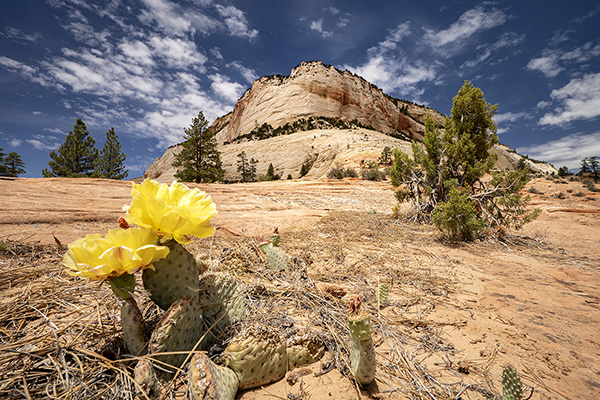
11-20mm (11mm), F/16, 1/100th sec., ISO 200
Click image to view larger
Ken was also impressed with the optical quality of the lens as he took in the scenery. “When most people think of wide-angle lenses, they usually think of some kind of distortion, like lines curving,” he says. “But thanks to the rectilinear correction of the 11-20, the lines stay incredibly straight.”
The 11-20mm’s F/2.8 minimum aperture, meanwhile, helped Ken capture low-light images while handholding. “When you’re shooting night scenes, including the Milky Way, that’s an incredibly important feature,” he says.
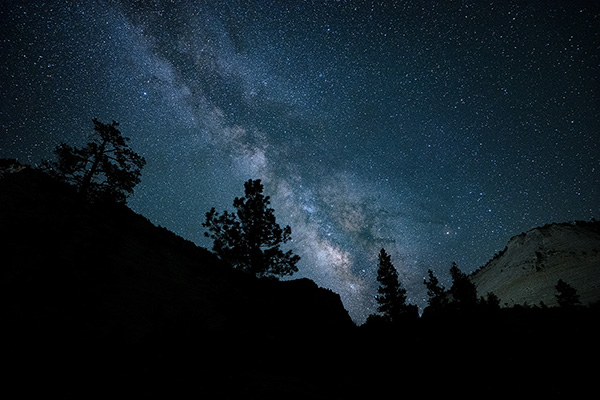
11-20mm (11mm), F/3.2, 25.0 sec, ISO 3200
Click image to view larger
Coatings are also key on wide-angle lenses, and the 11-20 is enhanced by Tamron’s proprietary BBAR (Broad-Band Anti-Reflection) G2 coating. “People often aren’t thinking about how the sun can come in straight at your lens and create ghosting and flare,” Ken says. “This new coating reduces all of that.”
The 11-20mm’s compact size and light weight (it’s just 86.2mm long and 11.8 oz.), moisture-resistant construction, and fluorine coating make it the ideal travel companion when trekking through the Southwest. “I used to carry around a 35-pound backpack when I was still using my DSLR, and now I’m down to 10 or 15 pounds, which is much easier on me when I’m shooting from sunrise to sunset,” Ken says. “Plus, the sturdy construction ensures it can stand up to the dust, sand, and other particulates you’ll confront in the Southwest.”
In general, when visiting locations that can be visually overwhelming, with seemingly endless landscapes of lines, colors, patterns, and shapes, Ken advises to keep it simple. “White Pocket is a place I’ve wanted to visit for a long time, so this was a must-see for me while we were out there,” he says. “But sometimes in a landscape like this, where you have so many lines and other visual elements intersecting, the viewer’s eye can lose focus.”
Take Ken’s photo here that shows a lone tree sticking out of the white rocks. “This is actually a fairly famous area,” he says. “Apple used these rock formations as backgrounds in one of its OS releases. There’s a lot going on in a scene like this, with all of those crisscrossing lines, so I zoomed in a bit and cropped it so the lines were coming in from the right, and behind that the lines came in from the left, moving to the tree itself. That overlap created depth in the image.”
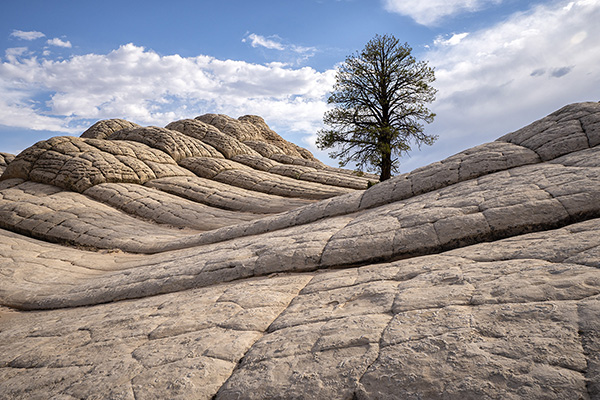
11-20mm (16mm), F/16, 1/40th sec., ISO 100
Click image to view larger
With the help of the 11-20mm, that same creative finagling helped Ken make visual sense of the next two photos, showing the same scene photographed about 30 seconds apart. “For both of them, I was once more using those lines and curves to draw the viewer’s eye toward the background,” he says. “For the second photo, I moved over about 10 feet to the left, got lower to the ground, and zoomed in from 14mm to 16mm. Whenever you take a picture, ask yourself: Is there something that I can capture that’s just a little bit better?”
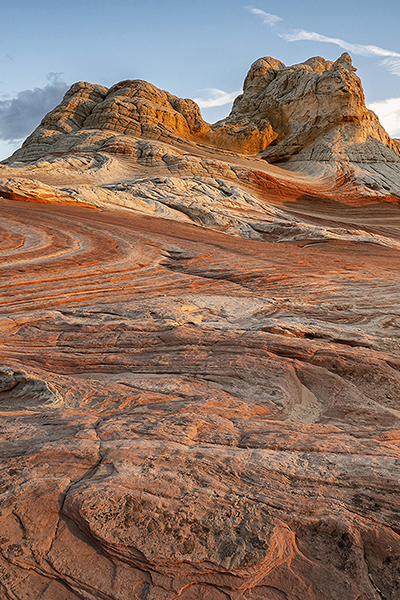
11-20mm (14mm), F/16, 0.4 sec., ISO 100
Click image to view larger
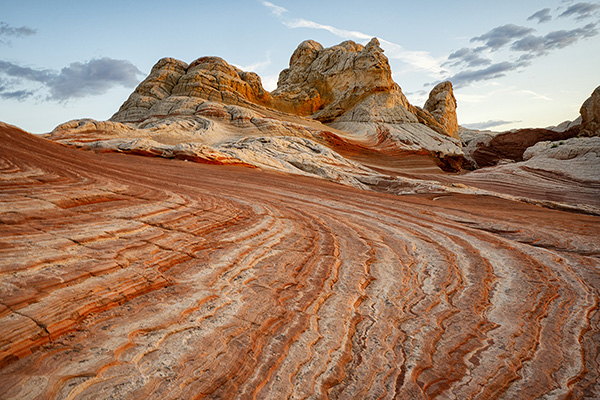
11-20mm (16mm), F/16, 0.4 sec., ISO 100
Click image to view larger
In Action
Check out Ken on some of his adventures with the 11-20 in Zion, Vermillion Cliffs, and the Grand Staircase-Escalante region in Tamron’s latest “In Action” video, shot by André Costantini.
To see more of Ken Hubbard’s images, go to www.kenhubbardphoto.com.
More Photo Tips | Watch Videos | Learn More About Tamron Lenses | Photo Gallery
